Продолжаем публикацию ознакомительных текстов по различным тематикам. В этой подборке текстов вашему вниманию представляется информация о двух столицах государств — Лондоне и Москве, а также рассказ о замечательном российском городе Орел.
Как было отмечено во вступлении к первой статье этого цикла, вам рекомендуется прочитать данные тексты несколько раз: первый раз — чтобы выделить и выучить незнакомые слова, второй — чтобы ответить на вопросы, третий — пересказать.
London
London was founded in the first century A. D. by the Romans. They left London in the 5-th century and the city was largely abandoned. By the 8-th century London was again a busy trading centre, and in the 11-th century it became the capital of England. Edward the Confessor built a palace and abbey at Wesminster. The Norman period saw the construction of the Tower, old St. Paul’s Cathedral and many churches and monasteries.
Medieval London grew in importance as a trading centre and in 1215 its citizens won the right to elect their own leader, or Lord of Mayor. London began to spread beyond the city walls during the Tudor and Stuart periods.
The Great Fire of 1666 destroyed three-quarters of the city. Sir Christopher Wren rebuilt St. Paul’s Cathedral and designed 51 churches. The rebuilding of London followed the medieval street plan, but the old wooden houses were replaced by buildings of brick to reduce the future fire risk.
During the 19-th century London spread rapidly into the suburbs. As a result of it new forms of transport were developed, including the underground railway system. Britain was then at height of her Imperial Powers and this is expressed in such buildings as the Houses of Parliament and St. Pancras Station.
Large areas of London were destroyed by bombs during World War II and the rebuilding that followed was of mixed quality.
Today in its full extent Greater London covers 625 square miles and consists of 33 separate boroughs, including the City, the West End, the East End and houses 7 million people.
The City extends over an area of about 2,6 square kilometres in the heart of London. About half a million people work there, but less than 6000 lives there. It is the financial centre of the UK with many banks, offices and Stock Exchange.
All the historical places and famous parks are in the West End. The West End, spreading from the political centre at Westminster includes the shopping area of Knightsbridge, Oxford Street, Piccadily and the fashionable Covent Garden; it hosts museums and galleries, among them are the Tate Gallery, the National Gallery and Portrait Gallery, the British Museum. In the West End there are Houses of Parliament, Westminster Abbey, Buckingham Palace.
The best known streets are: Whitehall with important governmental offices, Downing Strecl, the residence of Prime Minister and Fleet Street which stands for the press.
The name «West End» is associated with wealth, luxury and goods of high quality. The port of London is in the East End. It is an area of docks, unattractive in appearance, but very important in the country’s commerce.
Vocabulary:
abandon — покидать
abbey — аббатство
Edward the Confessor — Эдуард исповедник (король Англии в 1042-1066 гг.)
destroy — уничтожать
borough — округ, район
Stock Exchange — Фондовая Биржа
Questions:
1. When was London founded?
2. What were the most Important events in the history of London?
3. What is implied under Great London?
4. What is the City noted for?
5. What is the West End famous for?
6. What is there in the East End?
London places of interest
There are many places of interest in London. Among them are: Westminster Abbey, Houses of Parliament, Buckigham Palace, St. Paul’s Cathedral, London Bridge, the Tower of London.
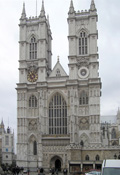 WESTMINSTER, now a political centre of London, was until the 11-th century a sacred place. King Edward the Confessor decided to build a great abbey church here. It was consecrated in 1065, but a week later the King died and was buried in the abbey. His tomb became a popular place of pilgrimage. It is still can be found at the heart of present Westminster Abbey. William the Conqueror was crowned in the Abbey and since then all Coronations have taken place here. WESTMINSTER, now a political centre of London, was until the 11-th century a sacred place. King Edward the Confessor decided to build a great abbey church here. It was consecrated in 1065, but a week later the King died and was buried in the abbey. His tomb became a popular place of pilgrimage. It is still can be found at the heart of present Westminster Abbey. William the Conqueror was crowned in the Abbey and since then all Coronations have taken place here.
The Abbey contains many royal tombs, memorials to eminent men and women. But the most popular ones are those to writers, actors and musicians in Poet’s Corner.
Alongside the Abbey Edward the Confessor had a palace built. The Palace of Westminster was the royal residence and also the country’s main court of law. Parliament has met here since the 16-th century until the 19-th century.
The present HOUSES OF PARLIAMENT were built after the old palace was burnt down in 1834, The building contains the House of Commons and the House of Lords, the two chambers where parliamentary business is debated. On the corner next to Westminster Bridge stands St. Stephans Tower, which houses the famous bell. Big Ben, which chimes the hours.
 BUCKIGHAM PALACE is the Queen’s official London residence. Built in 1702-5 for the Duke of Buckingham, it was sold in 1761 to George III. The Palace was little used by the royalty until Victoria’s accession to the throne in 1837. BUCKIGHAM PALACE is the Queen’s official London residence. Built in 1702-5 for the Duke of Buckingham, it was sold in 1761 to George III. The Palace was little used by the royalty until Victoria’s accession to the throne in 1837.
London’s most popular spectacle is changing the Guard which takes place in the forecourt and lasts about 30 minutes.
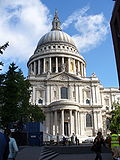 ST. PAUL’S CATHEDRAL is a masterpiece of Sir Christopher Wren. It stands at the top of Ludgate Hill on a site where a Christian church has stood since the 7-th century. The building of the Cathedral started in 1675 and was not finished until 1709. The magnificent classical structure is crowned by a cone. Inside the Dome are scenes from the life of St. Paul. Here too is the famous Wispering Gallery. There are many memorials in the Cathedral includuing those to the heroes such as Wellington and Nelson. ST. PAUL’S CATHEDRAL is a masterpiece of Sir Christopher Wren. It stands at the top of Ludgate Hill on a site where a Christian church has stood since the 7-th century. The building of the Cathedral started in 1675 and was not finished until 1709. The magnificent classical structure is crowned by a cone. Inside the Dome are scenes from the life of St. Paul. Here too is the famous Wispering Gallery. There are many memorials in the Cathedral includuing those to the heroes such as Wellington and Nelson.
 THE TOWER OF LONDON has been closely associated with many important events in English history. It has served as citadel, palace, prison, mint and menagerie. The White Tower was built in 1078 by William the Conqueror to’ protect the city. The Tower is famous for its illustrious prisoners, such as Sir Thomas More and Guy Fawks. Many notable people lost their heads on the executioner’block. The Tower is protected by Yeoman Warder at the Tower of London, known popularly as"Beefeaters". THE TOWER OF LONDON has been closely associated with many important events in English history. It has served as citadel, palace, prison, mint and menagerie. The White Tower was built in 1078 by William the Conqueror to’ protect the city. The Tower is famous for its illustrious prisoners, such as Sir Thomas More and Guy Fawks. Many notable people lost their heads on the executioner’block. The Tower is protected by Yeoman Warder at the Tower of London, known popularly as"Beefeaters".
Vocabulary:
sacred — священный
tomb — катала
pilgrimage — паломничество
to crown — короновать
coronation — коронация
royal — королевский
changing the Guards — смена караула
site — место, площадка
cone — конус
wisper — шепот
William the Conqeror — Вильгельм завователь
mint — монетный двор
menagerie — зверинец
Yeoman Warder at the Tower — хранители (стражи) Башни
Moskow places of interest
 Moscow is the capital of Russia. It was first mentioned in the records dated back to the year 1147. At that time it was a small frontier post. The history of Moscow is inseparably connected with the history of Russia. In 1237 Moscow fell under the yoke of the Tatars. And it was Moscow Prince Dmitry Donskoy who led the Russian troops to a decisive victory over the invaders in the battle of Kulikovo field in 1380. Moscow is the capital of Russia. It was first mentioned in the records dated back to the year 1147. At that time it was a small frontier post. The history of Moscow is inseparably connected with the history of Russia. In 1237 Moscow fell under the yoke of the Tatars. And it was Moscow Prince Dmitry Donskoy who led the Russian troops to a decisive victory over the invaders in the battle of Kulikovo field in 1380.
By the 15-th century Moscow turned into a wealthy city. It was under Ivan III that Moscow became the capita) of the state of Moscovy. At that time the Kremlin was rebuilt and the largest Kremlin Cathedrals were erected. Dung the Troubled Times Moscow was occupied by the Polish invaders. The fight to set Moscow free was identified in the people’s mind with the struggle for the national independence. The Polish invaders were routed by the popular levy headed by Minin and Pozharsky.
In 1812 the Napoleonic army entered Moscow. The city was set ablaze. The army had to retreat. That was a-’poor substitute for the military triumph in Russia, su much desired by Napoleon.
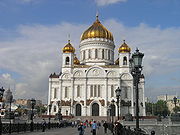 Nowadays Moscow is the largest city of Russia. It is a political, administrative, economic, educational and cultural centre of the country. There are many places of interst in Moscow. The city is famous for its historical monuments, museums, art galleries and theatres. The Historical Museum, the Pushkin Museum of Fine Arts, the Tretyakov State Picture Gallery is world famous. Moscow is proud of the Bolshoi, Maty and Art theatres. Moscow is an industrial centre with highly developed engineering, electric, light and chemical industries. Nowadays Moscow is the largest city of Russia. It is a political, administrative, economic, educational and cultural centre of the country. There are many places of interst in Moscow. The city is famous for its historical monuments, museums, art galleries and theatres. The Historical Museum, the Pushkin Museum of Fine Arts, the Tretyakov State Picture Gallery is world famous. Moscow is proud of the Bolshoi, Maty and Art theatres. Moscow is an industrial centre with highly developed engineering, electric, light and chemical industries.
Moscow is a scientific centre too. The Academy of sciences of Russia, the oldest university, many schools of higher learning, colleges and scientific institutions are located here.
Moscow is the country’s largest sports centre. It often becomes a scene of international sports festivals.
The city of Orel
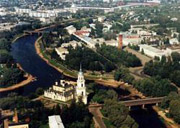 Orel is one of the regional centres of the Russian Federation which lies 382 km south from Moscow on a picturescue site at the confluence of the Oka and Orlik rivers with a popllation ofabot 4000,000. Now Orel is a large industrial and ’’ cultura city. Orel is one of the regional centres of the Russian Federation which lies 382 km south from Moscow on a picturescue site at the confluence of the Oka and Orlik rivers with a popllation ofabot 4000,000. Now Orel is a large industrial and ’’ cultura city.
Orel was founded in 1566 as an outpost ’to protect the southern borders of the Russian State. In the course of its more than four hundred years Orel witnessed many historical events and figured in quite a few of them. Orel is the birth place of Ivan Turgenev, the great Russian writer interlinked with the city is the life and creative work of many wonderful Russian writers and poets such as Nikolai Leskov and Leonid Andreyev, Ivan Bunin, the Nobel Prise I. aureate, Michait Prishvin, Feeder Tyutchev and Afanasy Fet who have purified the noble spirit of the Russian people and the beauty of Russian landscape.
Among points of interest in Ihe city is the Turgenev Literary Museum, the Leskov Museum, the Bunin Museum, the Museum of Orel writers, the Museum of Fine A rts, the Muselm of Regional Studies, the Museum of N .Russanov, one of the Russian polar explorers, the Turgenev Drama Theatre, one of the oldest theatres in Russia.
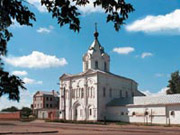 The best examples of Russian architecture of the lath century are St. Michait and Angels cathedral and St. Boris and deb’s church. The best examples of Russian architecture of the lath century are St. Michait and Angels cathedral and St. Boris and deb’s church.
There are some higher schools, many colleges and middle schools in our city, for example, the Politechnic Institute, the Teacher’s Training Institute, the Institute of Culture, the Commercial Institute the Agricultural Institue. Orel is a very green city and there are many forests around it. The most popular kinds of sports in Orel are skiing skating, cycle racing, gliding, football, gymnastics, acrobatics, horse racing and touring. Our city has the proud nam" Orel that means «eagle» in English. You are welcome to the city of Orel. |